

The English Apple Man and his friends have been Judging apple and pear orchards
At this time of the year the traditional orchard competitions are held. Many go back to pre-war (WW2) days and carry great traditions. The English Apple Man along with three industry experts has been scouring the orchards of West Kent in search of the very best examples of orchard management.
Last week on Wednesday, Thursday & Friday (29th, 30th, 31st July) The English Apple Man in the company of three good friends who also happen to be very, very knowledgeable about all the aspects of apple & pear growing, walked the entries in this year's NFU Goudhurst & Paddock Wood Orchard Competition.
Always enjoyable, this competition requires the Judges to appraise the whole farm, walking every orchard; marking each one on a list of criteria drawn up over the years by the founders and 'honed' by the custodians of the competition.
Key elements include; freedom from pest & disease - potential yield - commercial quality - orchard management - etc.etc...
Many of the issues found in commercial orchards will of course appear in EAM readers gardens. Lessons can be learnt which can be put into practice. Commercially red spider mite infestation is controlled with predators (30 years ago it was still only controlled with pesticides) - as the understanding of 'which and how' predators operate and importantly which chemicals are 'safe or not' to the various predators, growers, with the assistance of research institutes and their agronomy advisors have been able to reduce insecticidal applications.
Red Spider is seldom a problem in orchards where the orchard predatory mite Typhlodorums pyri is established.
Achieving biological mite control using T. pyri is minimally a one-step process and may require two steps. First, an environment must be established in the orchard that will allow T. pyri to survive and flourish. It is important that pesticides that are toxic to these beneficial mites are not used; and if T. pyri are not already present in the orchard, they must be introduced.
Below: Comparison of leaves with & without red spider infestation - and - Green Apple Aphis infestation
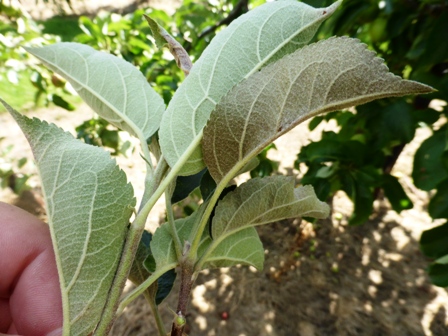
Control of scab depends on the use of fungicides, but encouraging good air movement in the tree ensuring trees dry out quickly after rain will reduce the periods of potential infection.
Below: Leaf Scab visible as dark patches - and - Scab on the surface of a Bramley apple
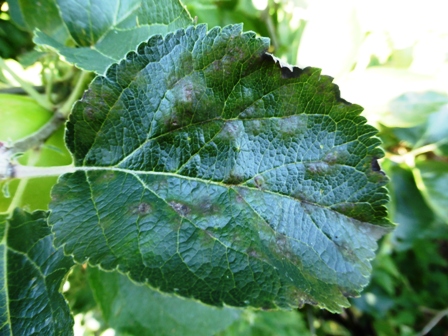
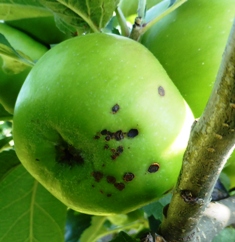
Control of Codling moth requires accurate monitoring of moth activity; using moth traps is the standard practice for determining the optimum timing of pesticides against codling moth.
Click to view Agralan Codling Moth Traps
Below: Damage from Codling Moth Larvae - and - Severe hail damage
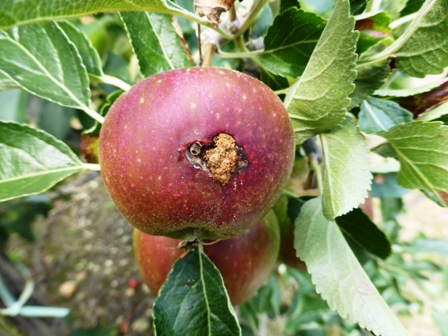
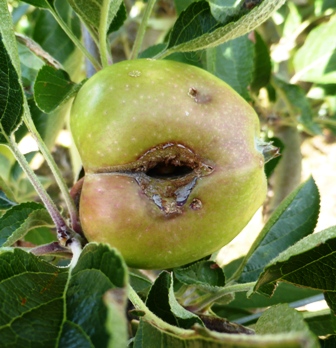
The Green apple aphid is attracted to the young green shoot tips - encouraging natural predators like lacewings; see AHDB predatory midge and lacewing larvae and spiders feed on green apple aphid. However, the black ant, Lasius niger, is usually attendant in green apple aphid colonies and defends them from predators.
Below: A Lacewing resting on an apple - and - a Lacewing Egg, just visible on its stalk above the apple
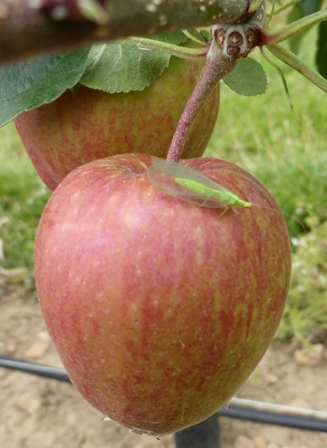
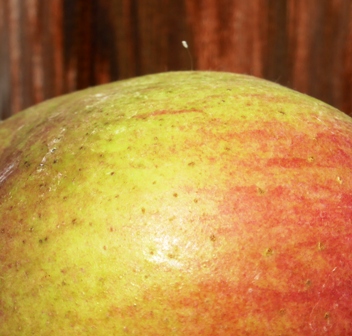
Click to view Lacewings
The pressure of increasing costs has encouraged some growers to make use of mechanical pruning; in general this has been used on narrow profile 'fruit walls' and more as a management tool than a cost saver, however on this farm in East Sussex which grows predominately Bramley, mechanical pruning has been used for many years. The older Bramley orchards have developed into wide beds of Bramley; the 'housy' nature of the beds makes Scab control harder, but the grower manages to keep an 'adequate' commercial control of scab especially as the majority of Bramley is sold for processing or onto the wholesale market. The farm does not actively seek to sell fruit to supermarkets where demands for 'near perfect appearance' are standard.
Mechanical pruning is becoming more prevalent and these Bramley have been mechanically pruned for many years
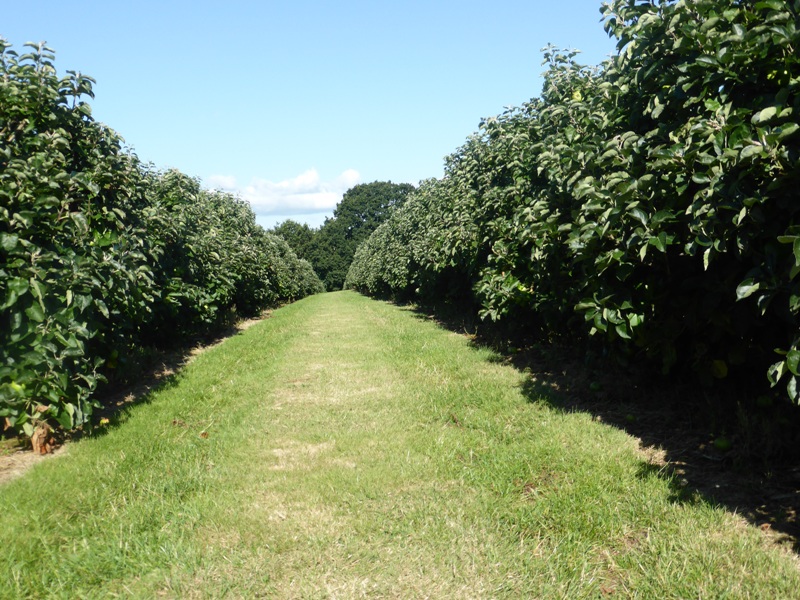
Below: The width of this mechanically pruned Bramley row is around 3 metres - and - Mechanical pruning cuts are visible in the second picture
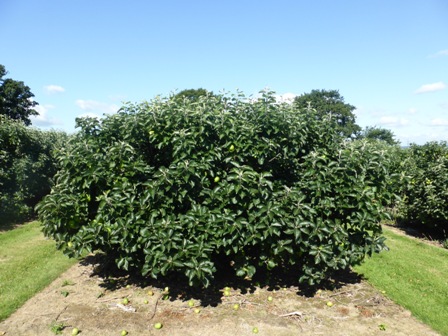
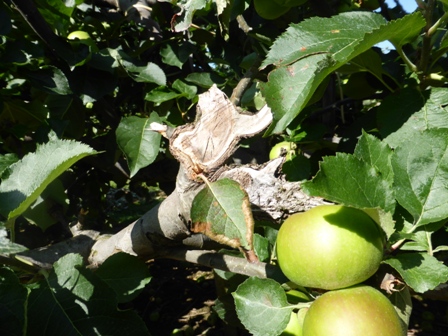
Summer pruning is an established practice in all apple orchards; removing unwanted vegetative growth improves light access which enhances the fruit quality (colour on dessert apples) and improves fruit bud quality for the next year. In these Bramley much of the unwanted shoots have been 'ripped by hand' rather than cut out with secateurs. Ripping reduces the return growth, while cutting encourages new growth.
Below: Summer pruning is now a routine task, but here the excess growth has been 'ripped' from the trees rather than cut - and - the suckers can be seen in the rows between the trees
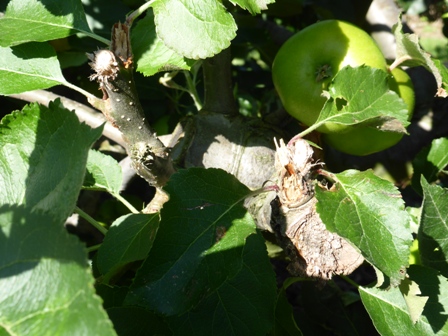
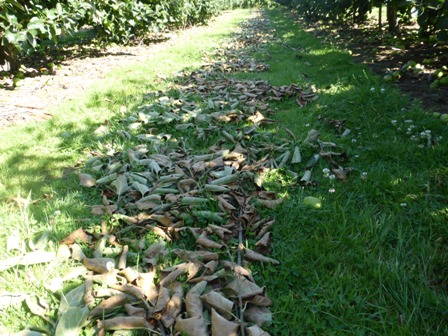
Removing suckers was a common practice when most apple trees were grown on a bush (or even standard tree) shape where the 'open bowl' shape resulted in water shoots (suckers) growing in increasing numbers 'year on year' - this is likely to be found in many 'mature garden trees' and gardeners can take the same action to reduce winter pruning and encourage light into the tree benefiting fruit bud quality for 'next' year.
Below: In these trees which have a more traditional 'bush' shape, this lady is removing the suckers from the centre of the tree, by 'ripping' where possible,or pruning with secateurs
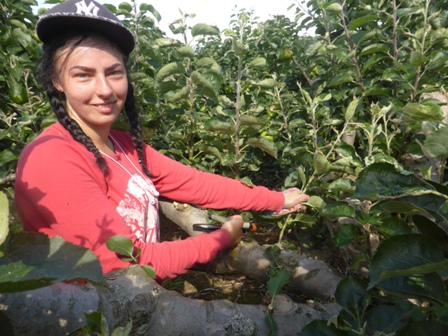
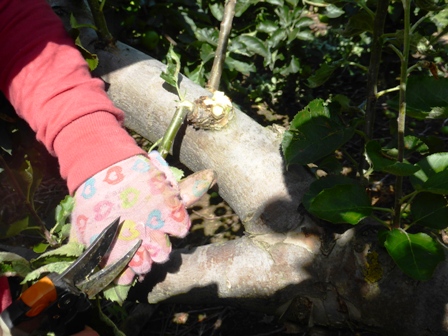
Once the suckers have been removed the tree has much more light.
Below: This tree has been suckered enabling more light to enter - and - the resulting suckers are visible under the tree
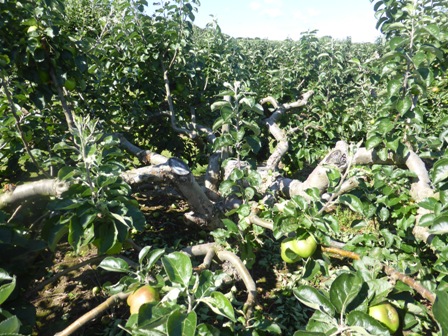
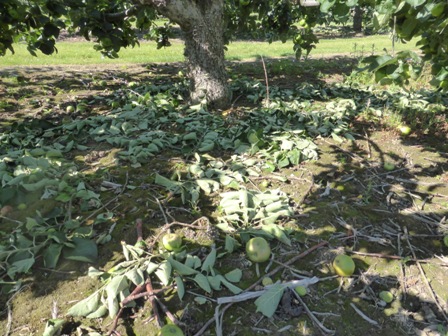
Below: A tree after suckering with its suckers beneath
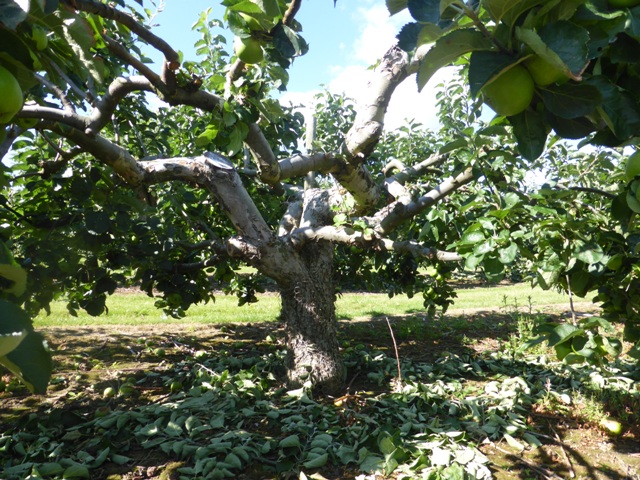
Orchard maintenance
From mature Bramley trees, to essential tasks in young orchards - as the young tree grows it important the leader is kept in the desired position close to the tree stake; if allowed to 'wave about' in any wind it may break, or at the very least damage young developing fruit buds. Here two ladies are tying in the leaders in this young Bibaum (twin leader) orchard at Wateringbury in Kent.
Below: Ladies tying tops in this Bibaum orchard - and Bibaum orchard
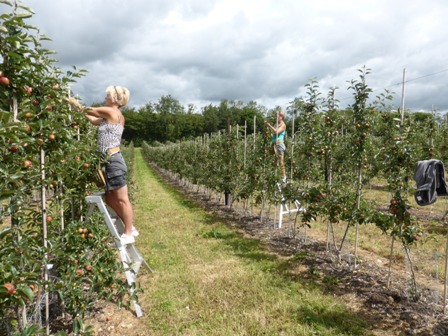
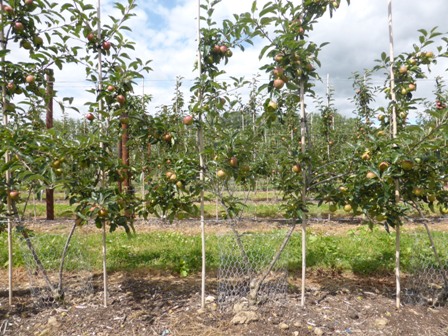
Thinning - gardeners take note!
Thinning is part and parcel of growing quality apples (and pears) and a task which gardeners should pay attention to as well. Thinning improves the size of the fruit in the current season and 'just as importantly' reduces the probability of biennial cropping. Commercially we want 'regular and even' crops annually and in the garden this should be the objective as well. Too often garden trees are left to their own devices and end up producing (at best) a bumper crop of small fruit, followed by a small (or no crop) next season, before the tree recovers in the next, or subsequent seasons and the 'cycle' starts again!
Below: Thinning has been important where initial set was high and/or hail damage needs to be removed
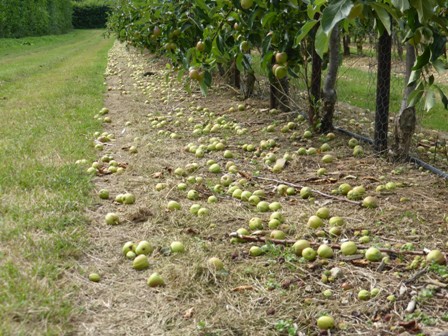
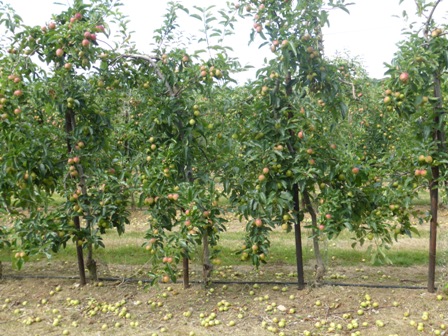
There is always something going on 'over the hedge' and this forage harvester was working steadily across the neighbouring field. In an orchard where a few Beauty of Bath apples were beginning to ripen, this wasp was taking advantage of a crack in the apple to get its 'first taste' of the new season apples.
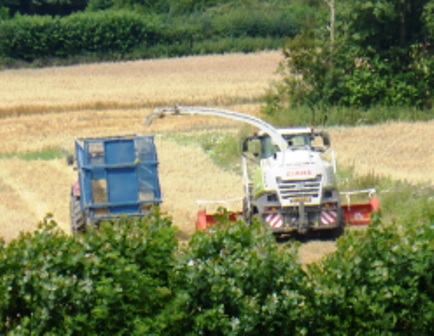
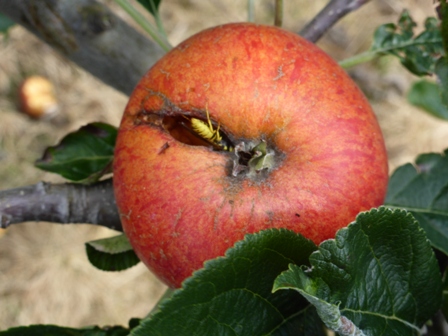
Decision time!
After three days of Judging we sat down in the NFU Office with Group Secretary and Orchard Competition organizer Martyn Webber who gathered all the scores onto his iPAD (a sign of the times) and announced the winners of the 'Overall Best Farm' competition and the various category prizewinners.
The differential between the leading contenders was small; Overall Winner 164 points - 2nd - 163 points - third - 162 points.
The standard was very high this year with very little sign of Scab (testament to the drier summer) and good control of mildew; testament to the management of the orchards in the competition in, what has been a more difficult year for controlling Mildew.
The quality of the fruit on all farms was very good; the margins between 'one farm and another' decided in many cases by the marginally superior crop or (adjudged) commercial value. Optimum size is a key factor in judging commercial value; in today's market place Supermarkets sell more and more by 'count' and the size profile can influence financial returns to the grower dramatically!
How does this work?
Apples are often sold (for example) by counts of 5, 6, 7, or 8.
Example: A count pack of 6 apples will have a minimum weight requirement; if the agreed count/weight ratio sets 6 apples at 90 grammes each (circa 60mm in size) or 6 x 90 = 540 grammes pack weight - if the size profile for the season is above the 'optimum' profile - say 65mm or 112.5 grammes, the pack weight will be 675 grammes. The give-away' is 25%!
This is of course only an example, but last season many growers lost 17% of their fruit value in give-away!
Below: Two pictures of Cox apples at Nigel Bardsley's Rectory Farm which won the prize for 'Best Overall Farm'
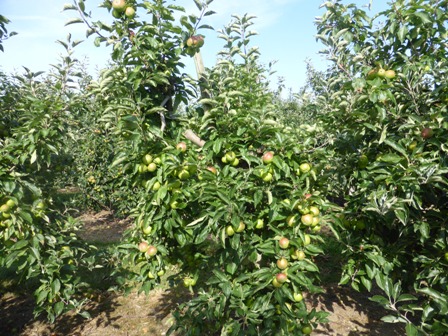
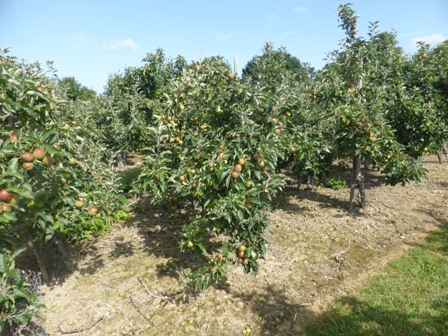
Below: More Cox at Heronden Farm which won 2nd prize in the Best Overall Farm Competition for Nigel Bardsley and a Bramley tree at Toke Farm; Toke Farm won the 3rd Prize in the Competition for Overall Best Farm for the Butcher Family.
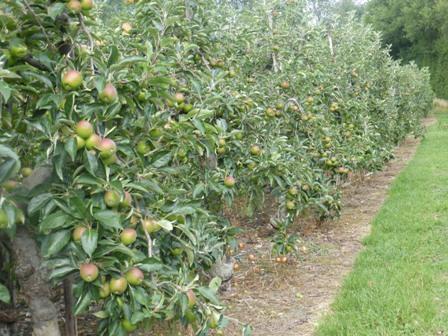
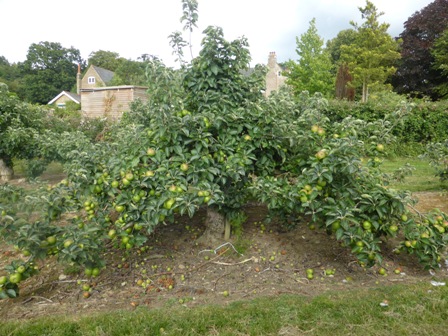
Below: The reservoir at Rectory Farm - a valuable source for irrigation and a valuable resource for biodiversity.

To finish this week's Journal - The English Apple Man indulges in his love for 'mans best friend' - on arrival at Barons Grange Farm on the Thursday morning (30th July) we were met by the most wonderful Jack Russell puppy - namely; farmer Charlie Ramus's new 15 week old Jack Russell puppy - 'Beach' a wonderful bundle of fun who explores (as they do) every new thing he comes across with 'wonderment' - be it Charlie's pen, "my fingers" - 'wow those razor sharp teeth' - even a flattened tin can and this Pear which he is guarding jealously!
Below: Beach attacking Charlie's pen - and - 'savouring a pear'
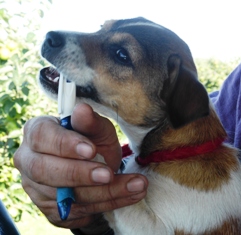
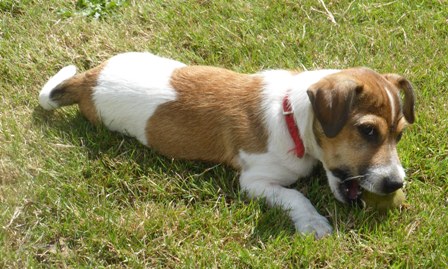
My apologies for the late publishing 'on line' of this week's Journal; The English Apple Man visited the Lake Constance region of Southern Germany with a small group of growers and advisors on Wednesday, Thursday and Friday in an intensive 'learning curve' and only arrived home at 1pm this morning (Saturday 8th August) - receiving an enthusiastic welcome from our Cocker Spaniel 'Poppy'
The subject of next week's Journal is still 'floating around my mind' with Lake Constance - a Zari Walk on Tuesday and Goudhurst and Paddock Wood NFU Orchard Competition presentations taking place at Nigel Bardsley's Rectory Farm on Wednesday evening all up for consideration!
Until next week.........
Take care
The English Apple Man